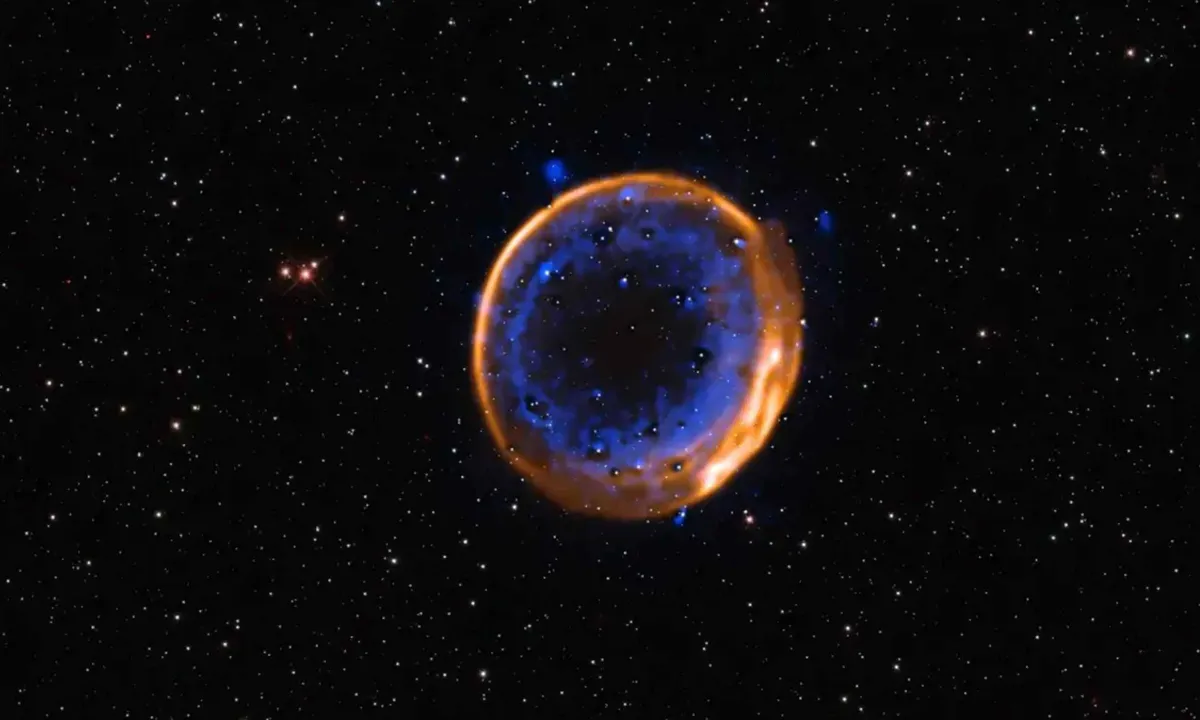
A groundbreaking revelation in astronomy has emerged with the observation of a star that died in a manner long theorized but never seen so distinctly. This fascinating event, observed in the Large Magellanic Cloud, a nearby dwarf galaxy approximately 160,000 light-years away, showcases the remnants of the star, known as SNR 0509-67.5, which continues to glow centuries after the explosive blasts.
In a peer-reviewed study, researchers reported the discovery of two distinct layers of debris surrounding SNR 0509-67.5, rich in calcium, with a layer of sulfur positioned between them. This structure aligns perfectly with existing models that predict the occurrence of a white dwarf star undergoing two linked explosions. The first explosion ignites in an outer layer of helium, followed by a second explosion in the star’s carbon-oxygen core.
The separation of the calcium into two concentric layers is indicative of the different regions in which each detonation produced calcium. The sulfur peaks in the intermediate zone, where conditions were most favorable for its formation.
A Type Ia supernova represents a powerful stellar explosion that can briefly outshine an entire galaxy. This phenomenon occurs when a white dwarf in a binary system ignites in a thermonuclear runaway. Such explosions release heavy elements into space, and their brightness can be calibrated to serve as distance markers across the cosmos, revealing the universe’s accelerating expansion.
As Type Ia supernovae act as critical cosmic yardsticks, understanding their ignition mechanisms is vital. If multiple ignition pathways exist, astronomers need to accommodate this variability in their models. The study of SNR 0509 provides compelling visual evidence that at least some Type Ia explosions occur before the white dwarf reaches its critical mass limit, suggesting a more complex triggering process.
In the proposed double detonation model, a thin layer of helium accumulates on the surface of the white dwarf. This helium becomes unstable and detonates first, creating a shockwave that travels around and inward within the star. This shockwave compresses the core, triggering a second, deeper explosion. The result is a single supernova event characterized by a two-stage ignition process.
The calcium signature of SNR 0509—comprising two distinct shells with sulfur in between—preserves the sequence of events within the expanding debris, providing crucial insights into the nature of white dwarf explosions.
Should some Type Ia supernovae explode below the Chandrasekhar mass—the maximum mass a white dwarf can attain before collapsing—the resulting brightness and colors may vary subtly. Proper calibrations are necessary to capture these differences and maintain accurate distance estimates. The calcium map derived from SNR 0509-67.5 serves as a forensic record, demonstrating that the white dwarf exploded in two stages rather than through gradual mass accumulation to a single threshold.
This discovery sheds light on why Type Ia supernovae are not uniformly consistent and aids in refining models that translate explosion physics into light curves and spectra. The iterative process of observation and modeling enhances our ability to measure cosmic distances accurately and clarifies the elemental composition produced by each ignition pathway.
The remnant itself is nearly spherical, expanding into low-density gas. Shock waves have stripped away the outer layers, revealing deeper structures of the ejecta. As the inward-moving reverse shock ionizes the debris, highly ionized calcium displays at two distinct radii, while sulfur peaks in the intermediate zone, confirming hydrodynamic predictions of a double detonation. Spanning approximately 23 light-years and expanding at over 11 million miles per hour, SNR 0509 is relatively young, allowing for clear reading of its internal stratification.
The presence of calcium in different layers within the remnant indicates various burning regimes in the star. The helium layer produces calcium at lower densities, while the core detonation forms calcium at greater depths. Sulfur's position highlights the intermediate density zone between the calcium layers, providing essential verification against models predicting a single sulfur shell. The simultaneous observation of both elements eliminates ambiguities that may arise from spectral analysis alone.
The minute Doppler shift between the two calcium shells suggests they are indeed separate layers, supporting a two-stage formation history. Furthermore, computer models simulating stellar explosions under fluid dynamics replicate the same structure observed in the remnant. When these models employ a white dwarf lighter than the Chandrasekhar mass, they yield two distinct calcium shells with a sulfur layer in between, mirroring the observational data.
Type Ia supernovae arise from various channels, including different types of companion stars. While the double detonation model accounts for a significant fraction, it is likely not the sole explanation. Future observations will seek to identify similar calcium-sulfur patterns in other young remnants, expanding our understanding of this phenomenon and its influence on brightness diversity.
Enhanced three-dimensional radiative transfer models will connect ejecta maps to observed colors, refining the standardization crucial for distance measurements. As methodologies converge, the cosmic distance ladder strengthens, ensuring a continued focus on the underlying physics rather than merely fitting data to models.
The findings of this study have been published in Nature Astronomy, marking a significant advancement in our understanding of stellar explosions and their role in the universe.
—– Like what you read? Subscribe to our newsletter for engaging articles, exclusive content, and the latest updates. Check us out on EarthSnap, a free app brought to you by Eric Ralls and Earth.com. —–